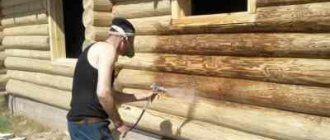In Russia, the problem of fires has historically become important. In the past, when wood was the main material in the construction of various buildings and structures, fires were enormous and destroyed entire areas of cities (for example, Moscow). And the main reason for this was the flammability of wooden house structures.
After a certain time, various engineering measures significantly minimized the number of fires. And one of them is fire protection of wooden house structures. Since wood is still used today (for example, in the construction of sloping roofs, as rafters, beams and sheathing). Let's consider methods of protecting wooden structures from the effects of open fire.
The need for fire protection
Protecting wood from fire is the main fire safety requirement for every building or structure, no matter during direct construction or during operation. The standards set out in local and regulatory documents must be observed, otherwise the facility will not be put into operation. This is a mandatory condition for specialized construction organizations.
When building a private house, any owner must also provide fire protection for wooden structures; this requirement is not in vain.
Fire impregnation of wood is carried out at the following intervals:
- before putting the facility into operation;
- every 5 years;
- as necessary, if during operation the properties of the impregnation do not provide protection.
The latter can be checked very simply: you need to remove a small section of chips and set it on fire and, accordingly, if a fire occurs, treatment with a fire retardant is necessary.
Fire protection of a wooden base is a measure to ensure fire safety requirements that must be followed throughout the entire Russian Federation.
List of wood processing methods:
- Carrying out finishing work using special fireproof materials.
- Measures to increase the fire resistance limit.
- Fire-retardant impregnation for wood using paint and varnish coating.
- At the design stage, it is chosen which method to apply to a particular design. The inspection is carried out by a representative of the fire service.
Fire retardant treatment is required for the following elements:
- rafter structures (load-bearing and non-load-bearing);
- timber walls;
- coatings and floors;
- beams;
- shingles for plaster;
- wooden panels inside and outside;
- other wooden surfaces.
On video: fire retardant wood treatment.
What are flame retardants
Fire retardants are called fire retardants . They prevent ignition and slow down the burning of structures that have already caught fire. Wooden parts are impregnated, painted or lubricated with fire retardant substances.
When heated, they evaporate into stable compounds that actively cool the material. The burnt layer of wood becomes an insurmountable barrier to the penetration of oxygen into the wood. At the same time, heat is removed deep into the structure, which prevents smoldering.
The types and use of fire retardant compounds are regulated by regulatory documents.
Normative documents
To impart fire-resistant qualities to load-bearing wooden elements of buildings and structures, norms and rules for the operation of wooden structures have been developed. They are specified in SNiP 21-01-97, GOSTs 30402, 30244 and Fire Safety Rules . The documentation contains requirements for the protection of wooden structures with fire-resistant impregnations. Each product is assigned a fire certificate.
Classification of fire retardant compounds
Fire retardant compounds (FR), in accordance with their characteristics, are divided into groups by type, operating conditions, level of resistance to aggressive environments and degree of penetration into the structure of the material.
Types of impregnations
The fire retardant composition for wood is selected based on the following parameters:
- Areas of use;
- appointments.
In total, there are 3 types of impregnations against accidental fires or fires of wood materials: acid, alkaline, salt. In this case, specialized fire retardants, paints, varnishes or enamels are used for surface treatment of wood. After their application, a thin layer is formed. Aqueous salt solutions are used for deep processing of structural elements.
Although these methods are widely used in practice due to their effectiveness, fire-prevention treatment is very successful. It not only meets fire safety requirements, but also fully guarantees:
- ensuring a high level of protection;
- long-term processing efficiency;
- consistency in color choice;
- compatibility with almost all further coatings;
- safety for both nature and people or animals.
Acidic compounds
This is the best solution for impregnating wood against fire. In this case, the color of the material does not change, and its structure remains the same. The acidic agent provides additional strength to the structural element, while the wood “breathes” and fully retains its properties. A huge range of products is available in retail outlets.
Alkaline compounds
The effectiveness of using such impregnations is low due to the disruption of the wood structure, so they are not recommended for treating visible areas. Such compositions are commercially available and their price is low compared to acid solutions.
Saline solutions
These formulations are not as effective. After treatment, salt stains appear over time, which not only spoil the appearance of the tree, but it becomes necessary to carry out the treatment again. As a rule, for external work the validity period of such coating is no more than 2 years, and for internal work - no more than 5 years.
It’s easy to prepare saline solutions yourself; the only drawback is that you can’t calculate the proportions.
Fire-retardant impregnation of wood on any basis contains substances that melt when ignited, forming a thin film, which in turn creates an obstacle to oxygen. Impregnation compositions based on alkalis, when in direct contact with fire, produce gases to prevent the persecution or spread of fire.
A preparation based on urea or furan-urea resins has gained great popularity, since it provides not only fire resistance, but also direct resistance to the perception of mechanical loads.
Among other things, the fire retardant drug is divided into:
- resistant to external manifestations - for outdoor work;
- unstable to atmospheric factors - for interior work.
Today there is a whole range of fire retardants on sale, which provide fire protection properties.
Frequency of processing
The protective coating must be renewed as soon as the applied fire protection has expired. This parameter depends on the type of material, processing technology, operating characteristics of the building, atmospheric characteristics and other factors. The performance properties of modern materials last 10-20 years.
A scheduled inspection should be performed once a year (according to PPR No. 390 in Government Decree No. 113 of February 17, 2014). If there are any shortcomings, the coating is restored or completely renewed.
Application of fire retardant paint
The very principle of impregnating wood against fire using the painting method is somewhat different from the direct effect of impregnation. Coating with antiseptic and fire-fighting compounds creates a layer to prevent heating and further fire of the structure. Once the wood reaches its combustion temperature, water and inert gases begin to be released. In addition, modern fire-retardant paints for wood have 2 functions simultaneously:
- from rotting;
- from fire or elevated temperatures.
Fire retardant paint is applied to the surface using rollers, brushes or a spray gun. The very frequency of wood treatment with a fire retardant coating is indicated by the manufacturer on the packaging, and even reaches up to 10 years.
Operating principle of wood fire protection:
| Name of the main property of the paint | Efficiency | Properties when exposed to ignition | Note |
| Intumescent | 1st efficiency group | During the period of direct influence of open fire, the pores formed by the paint crack, and at the same time, water and gas are released, including the expansion of the non-flammable layer. | Depending on the selected material, the thickness of the intumescent layer increases and ranges from 10 to 40 times. |
| Anti-intumescent | The layer providing thermal protection is present initially. The material contains liquid glass and fillers to create fire protection, as well as fire retardants. | Fire retardant compounds for wood belonging to this category actively resist fire for 2 hours. | The fire safety class of wood increases by 1 level. |
Wood compositions that provide fire protection are easy to select in a store, according to the manufacturer’s specifications.
Properties of fire retardant varnish
This paint and varnish material has all the properties for fire protection, as well as its functional purpose - for decorative application. When choosing this product and using it, the structure of the wood is preserved.
Fire-resistant varnish impregnation is used not only for processing the wood from which the structure is built, but also for coating furniture, wooden floors, laminate and other surfaces.
The main properties of this varnish include the following:
- the composition for wood ensures the fire resistance of the structure for a period of 6 to 10 years;
- Can be applied to a previously painted surface, except for a pre-applied water-based coating;
- Work with fire-resistant varnishes must be carried out at a temperature of at least +5 degrees;
- wood treatment after application increases fire protection;
- Fire protection varnish can be matte or semi-matte.
This fire-bioprotective impregnation is fully compatible with non-expanding materials. In this case, there is no need to additionally apply a layer of antiseptic.
Rules for treating wood with fire-fighting compounds
Fire protection of wooden structures is carried out in the warm season, since at low temperatures moisture is retained in the pores of the wood, preventing the effective absorption of the substance by the surface. Optimal conditions are from +10 °C and humidity no more than 70%.
The products are applied to finished buildings and structures, which then do not require mechanical treatment (if it is needed, accordingly, paint treatment is carried out after).
The humidity of the product should be no more than 15%.
additional information
Wood processing is necessary, and there is also other important information about this:
- Fire retardant materials for wood, despite their relatively high price, quickly pay for themselves, especially since their consumption per 1 m2 is not so high. This characteristic is indicated by the manufacturer. In addition, it also contains an antiseptic.
- The drug intended for processing must have a certificate of conformity.
- Fire retardant treatment at enterprises is carried out by specialized organizations.
- The layer impregnated with a fire retardant composition will last a long time.
- The resulting fire will not affect all structures.
- The purchased drug should not be skimped on when applied, otherwise the desired effect will not be ensured.











